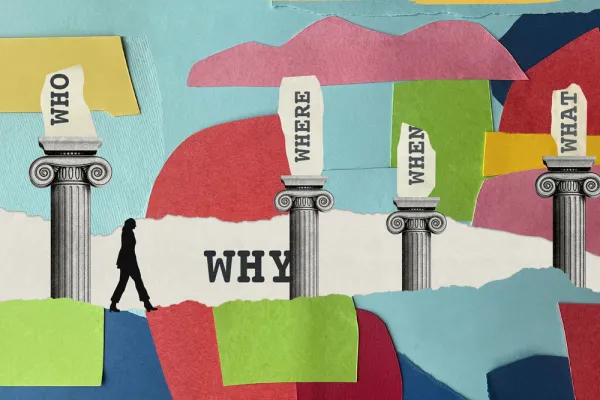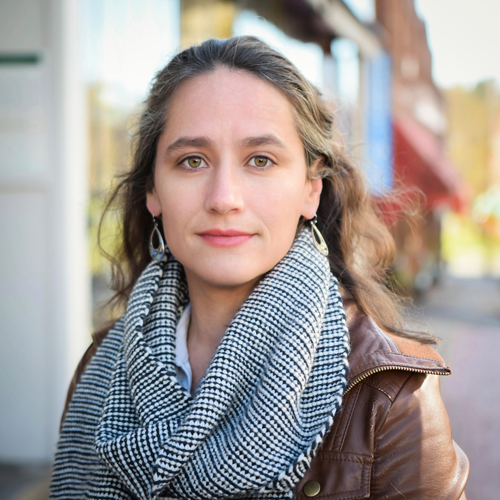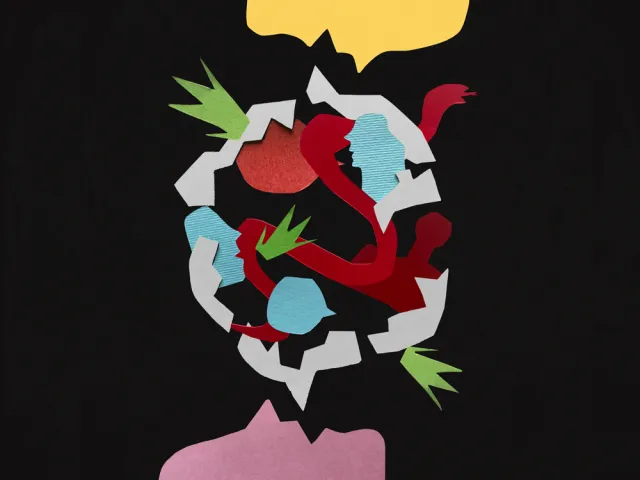Who Needs Journalism?
Campus Life
The press, democratic practice—and the liberal arts

Published January 9, 2023
A free, independent, and diverse press is often called one of the pillars of democracy.
Yet for decades, as a matter of principle, journalism courses did not count for credit at Smith College. The first course explicitly aimed at teaching journalism hit the Smith curriculum just five years ago.
Traditionally, journalism has been viewed by liberal arts institutions as a “pre-professional” educational track that teaches students a “trade”: a set of mechanics by which the practitioner translates current events into text. Like building a car—simple physical practices that convert parts into motion.
At its worst, journalism is seen as slapdash, sensationalized, oversimplified, and misleading, taking the real world’s full-bodied complexity and reducing it to a skeleton. In a perspective historically informed by privilege and class (newswriting was once a career pursued largely by the lower classes), journalism has been viewed as unworthy, beneath the rigor of the truly scholarly liberal arts endeavor.
Such perspectives are changing. The years following the 2016 election hastened a recognition that we ignore the media landscape outside the walls of the academy at our peril. The proliferation of fake news, the “filter bubble” fragmentation inherent to social media, the partisan battle over the soul of public discourse, and a metastasizing disagreement about what even counts as “fake” have all contributed to the newly fragile standing of American democracy.
Good journalism in a complex world, as it happens, needs strong critical thinking by skilled practitioners. The academy, meanwhile, suffers a dearth of practices to share its knowledge beyond the walls of the ivory tower.
While we may not be able to fully know the truth, its outlines are definable.
In fact, many of the principles that underpin journalism at its best are fundamental to the liberal arts. Accuracy. Independence. Fairness and impartiality. Thoroughness. Accountability. Humanity.
Students can benefit enormously from bringing a journalistic lens to their liberal arts studies. That mindset encourages them to ask: Why does this work matter? Why does it matter now? When students shape their work around these questions—and learn to articulate the answers for a broad public that may not take that importance for granted—they can only strengthen their grasp of their own intellectual endeavors.
The two worlds have much to offer each other if we let them—and Smith has begun opening the door to exploring that relationship. This year marks the kickoff of the college’s new journalism concentration, an interdisciplinary program for which students complete three core journalism courses, three electives from across the curriculum, and two journalistic internships. Pursued alongside their majors and minors, the concentration invites students to fuse journalistic approaches with their disciplinary knowledge.
Public discourse initiatives encouraging both journalism and public communication of all types have also exploded across the Smith campus. The Jacobson Center for Writing, Teaching and Learning now showcases published student writing on its Smith Public Voices site and holds a competition to select the strongest writing by first-year students for its Smith Writes digital literary magazine. Amplify, a competition run by the Wurtele Center for Leadership, promotes student leadership in public-facing art and writing. Courses across the disciplines now include public writing, podcasts, or other public discourse projects, some featured on the Jacobson Center’s site Of Note.
Journalism can help humanize academic work for students. Journalists are trained to find the telling anecdote, the individual story, the “central compelling character” who can embody the emotional import of general themes. For Smith students motivated seemingly more and more each year by social justice activism, such practices can satisfy their hunger for immediate social and human connection in their studies.
Journalism further urges its practitioners to remain unsatisfied with the single perspective. Good journalists always inquire: Who else knows about this? What other perspectives are out there? Who disagrees? As Roy Peter Clark, a senior scholar at the Poynter Institute for Media Studies, puts it, “Report the truth? Whose truth?”
Both journalism and the liberal arts acknowledge, though, that while we may not be able to fully know the truth, its outlines are definable. Importantly, both endeavors provide tools to enable that delineation—from rigorous sourcing to the scientific method to critical reading skills to editorial review. As Clark adds, “Truth—with a capital T—is unattainable, [but] even though you can never get it, with hard work you can get at it.”
Not only can journalism strengthen students’ experience in the liberal arts, but the liberal arts can improve the practice of journalism.
Newswriters have long had their own arms-length relationship with the academy, often stereotyping scholars as excessively detail oriented, removed from real-world concerns, enmeshed by the jargon of their disciplines, and unable to relate to the needs of the public.
Journalists not infrequently rely, too, on ways of producing the news that eschew lengthy deliberation and research, prioritizing the voices of sources over their own—even sources who may be biased or untrustworthy. Answer “who-what-when-where-how,” plug the answers into a classic journalistic structure like the upside-down pyramid, grab an opinion or two from the opposing side, and file with your editor. Fast.
To survive the pace of the news cycle, all good daily journalists need to master those skills. But in today’s world, it’s crucial for even daily journalists to cultivate not only the critical faculties but the courage to point out when something smells “off”—when there’s a hidden untruth, a fishy statistic, or a source’s outright lie. Or, for that matter, when there’s more to a story than meets the eye.
A strong liberal arts education teaches those skills: asking questions, doing the research, sourcing carefully, exploring multiple angles. It encourages the rigor required not to be satisfied with the simple answer.
It also grounds students in the content necessary to grasp the full import of any given event, fact, or anecdote. “The mark of an educated person is that they can be emotionally moved by statistics,” I tell my students each year, quoting former White House science adviser Rosina Bierbaum.
It doesn’t take them long to work out why. Education—an accumulation of knowledge and thinking structures—provides contextual landscape to a statistic, suggesting the questions to which it gives rise and, most importantly, the human impact of its consequences. Such context is also what an impactful journalistic article provides.
By directly teaching Smith students journalistic structure, writing style, ethics, and methods, and by encouraging them to write for the public even while they pursue majors in the disciplines, we can seek to harness the best of both worlds.
Students who publish their work, whether within or beyond the Smith community, will additionally gain the indescribable satisfaction of knowing that their learning is having an immediate, real impact. Their studies right now, even as undergraduates, will jump the bounds of the ivory tower, allowing them to share some of the fruits of the immense privilege of their Smith education with a broader audience. Journalism offers a uniquely equalizing power in our world of inequalities.

Naila Moreira directs the journalism concentration at Smith.
This story appears in the Winter 2023 issue of the Smith Alumnae Quarterly.
Democracy in Distress
A Special Series

Big Little Lies
Disinformation is degrading our democracy. Smithies are striving to shore it up.
by Andrea Cooper ’83
Pull Up a Chair
A student perspective on free speech.
by Olivia Petty ’26
Illustration by Franziska Barczyk
